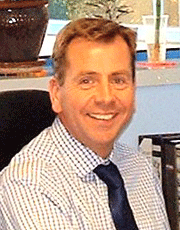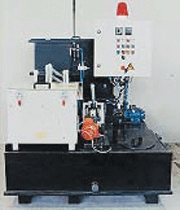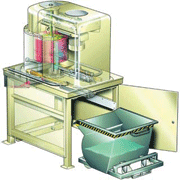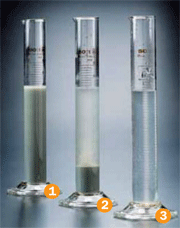E-Archive
Good Vibrations
in Vol. 8 - July Issue - Year 2007
Waste Water Treatment / Recirculation For Vibratory Mass Finishing Processes

Paul Rawlinson

Z800 HA Turbo-Floc

Z 1000 ASS-11 Turbo-Floc

1: Process water before treatment 2: Process water after adding coagulation liquid (The large agglomerated solid particles, which are easy to separate, can be made out clearly) 3: Process water after treatment in a centrifuge (The solid matter had been separated as sludge cake in the centrifugal drum)
Many companies still choose to ignore practices that damage the environment and waste money
Almost without exception vibratory mass finishing processes are wet. In other words they all use water normally together with a liquid compound and media, without these materials it would be impossible to achieve the desired finish.
All vibratory mass finishing waste water, which includes waste from disc machines and barrels, etc contains small metal particles, sludge that is a by-product of the media depreciation (normally ceramic or plastic) and spent liquid compound, all a cocktail that should be treated.
In many instances the process waste water is not treated and reused but instead discharged to drain, sometimes passing through a filter or settlement tank, other times simply being discharged directly to drain. This is not only damaging to the environment, wasteful and cost inefficient but in some situations totally illegal.
Local water authorities will issue a trade effluent consent to discharge in which the discharge parameters are set, the limits for allowed metals are indicated as well as grease, oil and other contaminates, the pH is always stipulated. The consent to discharge will also highlight the metals and other materials that under no circumstances can be discharged to drain, should this happen enormous fines are often enforced and if the waste discharged falls slightly outside the allowed parameters this normally results in the company in question having regular and often disruptive visits by the water authority.
The local water authority charge the user for the treatment of the effluent they discharge, in this instance the user is indirectly paying for the treatment of the waste they produce. Often these charges can be significant especially as legislation is regularly updated, resulting in the level of contamination discharged being reduced and the treatment costs increased, some authorities review charges more than once a year making it very difficult for the user to control costs.
When selling vibratory mass finishing machines or offering process advice it can sometimes happen that the customer is not offered the correct advice regarding the subject of waste water. From experience we find that this is normally the case when the seller cannot offer a solution because the equipment required is not in his portfolio and/or he lacks knowledge, so his target is to sell the process machine and not to raise any concern regarding waste water. However this is wrong and irresponsible, the user should always be made aware that he cannot simply discharge to drain and if explained correctly the user can realize the many advantages of a modern waste water treatment/recycling system.
Modern equipment can remove and separate the offending materials so that the waste water can be treated and reused.
In most applications 95% of the water and compound used can be saved, this alone can be a huge cost advantage, add to this the removal of the solids, sludge and metal particles, a reduction (sometimes elimination) of local water authority charges, a reduction in the transportation costs of the previously used compounds that are now replaced with compounds that can be recycled and the whole idea of an investment in a waste water treatment/recirculation system is a viable proposition.
The modern waste water treatment/ recirculation system is in the form of a high speed centrifuge, configured with a collection vessel or dirty tank, clean water tank and a series of pumps to control and distribute both effluent and treated solutions.
The physical separation output of the centrifuge is determined by the quality of the process water that has to be cleaned in one hour. The viscosity of the water and compound compared to the specific weights of the solids (sludge and metal fines, etc) have very different weights so the high power centrifuge "g-value" (2100g) forces the two constitutes apart, however very small particles (<1 ?m) with a specific weight similar to water cannot be separated in the mechanical centrifuge stage so special coagulation liquids have been developed, and when added at very low dosing rates 0.1 – 0.5kg/m3 to the effluent these very small particles can also be separated. The coagulation liquid creates an agglomerate of the finest particles (fig 2) so that when the waste water is passed through the centrifuge the resulting treated water is ready to be reused (fig 3), no salts are returned to the process which means that the lifetime of the water is maximized. To optimize the whole performance of the recirculation process it is advisable that the compound used in the vibratory mass finishing process contains anti-foaming properties as well as anti-bacterial agents so to prevent any bad odours and foam build-up that can occur if conventional compounds are reused for extended periods.
If companies wish to save costs and have a compliant system, the centrifuge waste water treatment and recirculation system is a cost-effective solution to many vibratory mass finishing processes.
Other applications for the centrifuge include the inclusion in the closed loop system of the WET SHOT BLASTING PROCESS, especially for very precise separation replacing the less efficient sack and band filters.
Good Vibrations
by Paul Rawlinson,
Contributing Editor MFN and
General Manager Rösler UK
Tel: +44.151.482 0444
Fax: +44.151.482 4400
PRawlinson@rosleruk.com



























